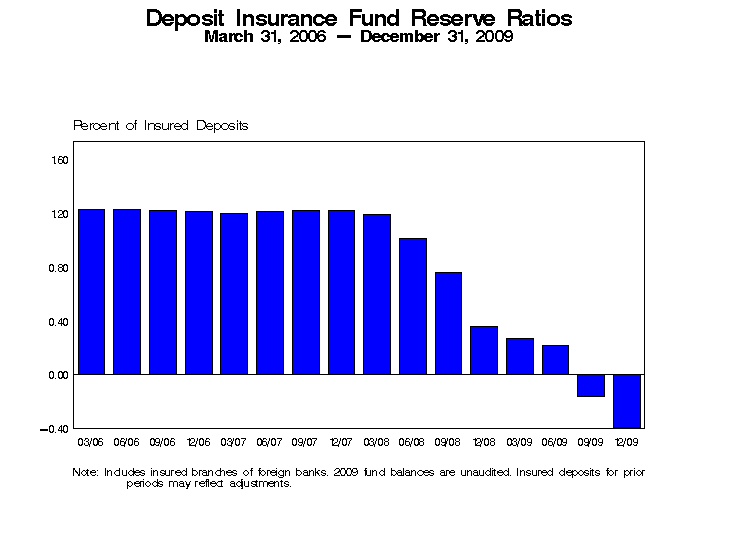2010 Banking Failures Increase To 30 As Three More Banks Fail
The banking failures continue as regulators closed three more failed banks. The three failed banks for March 12, 2010 had total assets of $1.1 billion and total deposits of $1.0 billion. The cost to the FDIC Deposit Insurance Fund (DIF) for these latest banking failures is estimated at $183.4 million. The cost to the FDIC DIF for the 30 banking failures to date in 2010 now totals $4.9 billion.
The assets and deposits of all three failed banks were taken over by other institutions under purchase and assumption agreements with the FDIC. As has been the case with almost all recent banking failures, the FDIC agreed to absorb a portion of the losses on purchased failed bank assets through a loss-share agreement with the acquiring banks.
FDIC Insurance Fund Is Depleted – Taxpayer Funded Bailout May Be Inevitable
Banking analysts are predicting that banking failures in 2010 will greatly exceed last year’s total of 140, which is the largest amount of banking failures since 1992. Banking institutions continue to collapse as loan defaults soar and residential and commercial property values continue to erode. As of December 31, 2009, the latest FDIC Quarterly Banking Profile revealed that there are 702 Problem Banks, up from 252 at the end of 2008, a 178% increase.
Total assets of Problem Banks totaled $402.8 billion at December 31, 2009. A bank does not wind up on the Problem Bank List unless it is having severe financial difficulties. Recent bank closings have seen average FDIC losses equivalent to 25% of failed bank assets. Applying a 25% loss rate to the $403 billion in assets held by Problem Banks at year end 2009 implies potential future losses of over $100 billion. Potential losses could be even larger as the number of Problem Banks increase. Can the FDIC handle losses of this magnitude without a taxpayer bailout?
The FDIC Deposit Insurance Fund (DIF) declined during the fourth quarter to negative $20.9 billion due to provisions for bank failures totaling $17.8 billion. The DIF reserve ratio at December 31, 2009 was a negative .39%, the lowest reserve ratio on record. The FDIC, the protector of depositor funds and public confidence in the banking system proudly boasts that the FDIC receives no federal tax dollars. (FDIC funding is obtained by assessing insured deposits of member banks.) Despite FDIC assurances, when considering the magnitude of potential losses on failed banks, the FDIC may eventually need to access the $100 billion line of credit with the Treasury that they requested and were approved for in 2009.
The FDIC’s viewpoint on the line of credit with the Treasury was spelled out by the FDIC as follows:
Even though the FDIC has significant authority to borrow from the Treasury to cover losses, a fund balance and reserve ratio that are near zero or negative could create public confusion about the FDIC’s ability to move quickly to resolve problem institutions and protect insured depositors. The FDIC views the Treasury line of credit as available to cover unforeseen losses, not as a source of financing projected losses.
Should extraordinary circumstances arise, the FDIC also has the authority to borrow up to $500 billion from the Treasury with the consent of both the Federal Reserve and the Treasury Department.

Park Avenue Bank, New York, NY – Banking Failure Number 28
The FDIC entered in a purchase and assumption agreement with Valley National Bank, Wayne, NJ, to assume all deposits and purchase virtually all of the assets of Park Avenue Bank. At 2009 year end, Park Avenue had assets of $520 million and deposits of $495 million. The FDIC and Valley National entered into a loss-share transaction on $380 million of Park Avenue’s assets to limit potential losses to Valley National. The FDIC expects to lose $50.7 million on the failure of Park Avenue, which is the second banking failure in New York this year.
Old Southern Bank, Orlando, Florida – Banking Failure Number 29
The FDIC entered in a purchase and assumption agreement with Centennial Bank, Conway, Arkansas, to assume all deposits and purchase virtually all of the assets of Old Southern Bank. At 2009 year end, Old Southern had assets of $316 million and deposits of $320 million. The FDIC and Centennial entered into a loss-share transaction on $282.7 million of Old Southern’s assets to limit potential losses to Centennial. The FDIC estimates the cost to the Deposit Insurance Fund at $94.6 million. Old Southern is the fourth banking failure in Florida this year.
Statewide Bank, Covington, Louisiana – Banking Failure Number 30
The FDIC entered in a purchase and assumption agreement with Home Bank, Lafayette, LA, to assume all deposits and purchase virtually all of the assets of Statewide Bank. At 2009 year end, Statewide had assets of $243 million and deposits of $209 million. The FDIC and Home Bank entered into a loss-share transaction on $164 million of Statewide’s assets to limit potential losses to Home Bank. Closing Statewide is expected to cost the FDIC DIF $38 million. Statewide is the first banking failure in Louisiana this year.
Speak Your Mind
You must be logged in to post a comment.